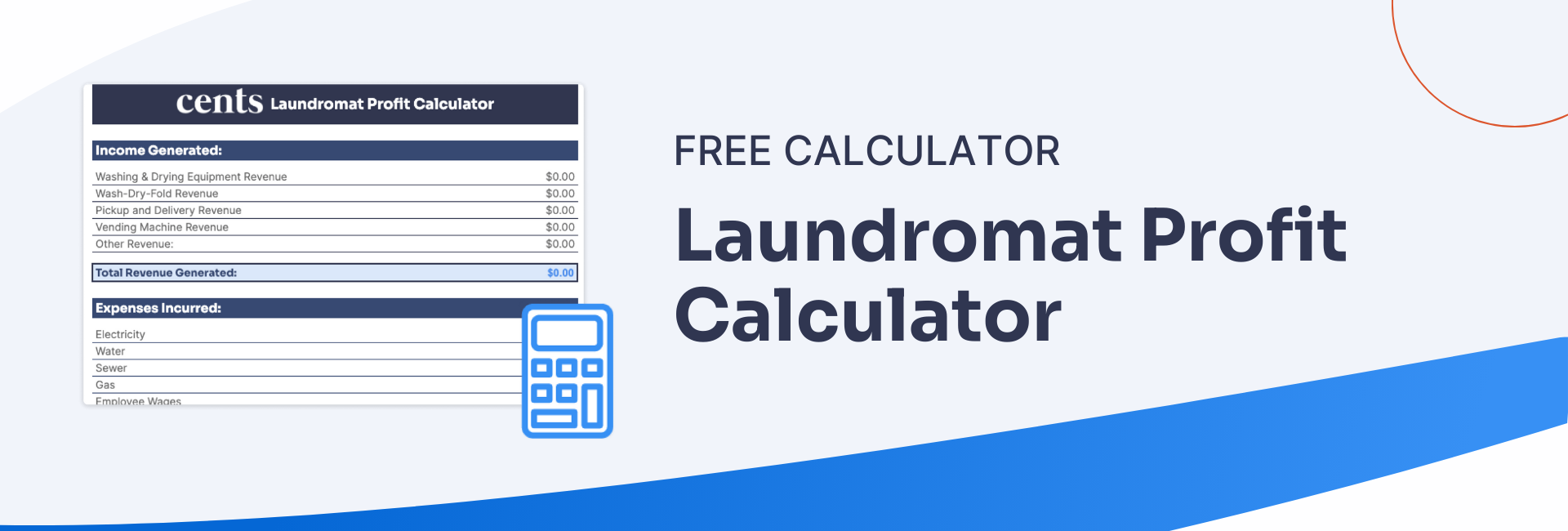Understanding your laundromat, how it operates, and your customers’ behaviors is essential to unlocking untapped potential and growth. This means understanding all debts, costs, and revenue. Unfortunately, too many laundromat owners want to wait until there is a decline in sales or a silent partner before they start tracking laundry metrics.
Utilize our intuitive profit calculator to quickly and accurately project the potential earnings and operational costs of your laundromat, empowering you to make informed financial decisions.
Tracking your laundromat metrics could mean success or failure for your business. Without metrics, you’re operating on instinct and feeling rather than facts and data. Tracking actual laundromat analytics helps you make informed business decisions to identify opportunities, benchmark revenue, and allocate resources efficiently.
In order to get a grasp on your business, you need to identify the key performance indicators, or laundromat KPIs, to best measure your business. Tracking KPIs can assist in decision-making, help set strategic goals, and allow you to evaluate your business in real-time. While KPIs may differ for each laundromat based on the types of service you offer and the goals for your business, here are 6 of the top key laundry metrics you should consider tracking:
-
Total Revenue
-
Total Revenue by Service Type
-
Total Revenue Per Machine
-
Machine Operation Costs
-
Average Order Value
-
Debts
By monitoring these laundromat analytics, laundromat owners can maximize the profitability and productivity of their businesses. In this article, we’ll break down each of the six key laundromat metrics, and discuss how and why you should be tracking them.
1. Total Gross Revenue

Laundromat owners should be calculating daily, weekly, and monthly revenue. This not only helps you understand how much revenue you’re generating but also pinpoints which days are the slowest so you can work on optimizing them.
Weekly and monthly revenue will help you better gauge overall revenue, and the daily will help you account for any slow days or peak performance periods. Knowing daily revenue can also help you when offering promotions. If revenue is low one day of the week versus another, you can offer incentives to entice customers to do laundry on less-busy days.
Keep in mind, you don’t want to look too closely into the daily monitoring. Constantly reviewing those numbers can lead to an obsession with those down days that could be cause of factors outside of your control.
2. Total Revenue by Service Type
If you offer multiple services at your laundromat, it’s important to track the total revenue generated by each service. This way, you’ll be able to determine the profit by segment and track how well a service is performing. This can include:
-
Self-Service
-
Wash-Dry-Fold
-
Pickup and Delivery
If one of them is not generating enough profit, it could mean there is local competition or a pricing issue. With these laundromat analytics, you can make the right move for your business whether that be more marketing or other solutions.
3. Determine the Laundromat’s Trajectory
Calculating the total revenue per machine by size and location in the store can help analyze the store’s prime equipment placement location and favorite washers. Knowing these numbers can help you make decisions about where to place certain machines to maximize performance and boost potential revenue.
Different machines and cycles will bring in different amounts of revenue. The revenue you bring in for various machines can help you determine if you need more machines that bring in more revenue or need to get rid of the ones that are bringing in the least amount.
Tracking laundry metrics like turns per day—how much laundry is being processed per day by each machine—will help you monitor trends and optimize traffic. A common rule of thumb is to aim for three turns per day.
4. Machine Operation Costs
%20%20-%20blog%20blob.png?width=256&height=256&name=BestWash%20(2)%20%20-%20blog%20blob.png) Conducting regular machine audits is crucial to controlling costs within your laundromat. By tracking error codes, service requests, and maintenance by machine, you can spot patterns in the frequency of these types of alerts and get to the bottom of a root cause.
Conducting regular machine audits is crucial to controlling costs within your laundromat. By tracking error codes, service requests, and maintenance by machine, you can spot patterns in the frequency of these types of alerts and get to the bottom of a root cause.
Key laundromat metrics to track include:
-
How many times has a machine been out of order
-
The associated costs with repairs
-
Revenue lost for machine downtime
For coin-operated laundromats, machine audits should tie in with the collection frequency. Those using hybrid and card-operated stores most likely have access to software for revenue reporting and management automation to keep track of the machine operation laundromat analytics.
5. Average Order Value
If you offer services like Wash-Dry-Fold and Pickup and Delivery, tracking your laundromat analytics around average order value is for these segments.
Knowing your laundromat’s average order value helps you evaluate your pricing strategy and marketing efforts, providing you with the metrics needed to measure the long-term value of individual customers. Average order value serves as a benchmark for your customers’ laundry behavior, which helps with goal setting, strategy enhancement, and evaluation of current business strategy. When you know the average order value, you can improve upon it, directly improving profit and revenue growth.
Knowing the average order value also offers a window into your laundromat customers’ behaviors and how much they spend at your business. You can plan pricing and marketing to improve when you understand what they spend per Wash-Dry-Fold or Pickup and Delivery order.
To calculate the average order value, you’ll need to add the total revenue and divide it by the total number of orders placed in a given period.
6. Debts
Tracking your laundromat’s fixed and variable costs will help you gauge and document the laundromat’s profitability. As an operator, you’ll be able to identify and react to opportunities and issues quicker than waiting for the problem to present itself.
-
Fixed costs include consistent costs that do not change month-to-month. This includes numbers like insurance, debt service, rent, and any services you use to enhance your laundromat experience like TV.
-
Variable costs include utilities and labor. Utility costs make up a significant part of recurring costs for owners. Managing energy and water costs is a good way to control your overall expenses.
Variable costs include utilities and labor. Utility costs make up a significant part of recurring costs for owners. Managing energy and water costs is a good way to control your overall expenses. To identify if your utilities are eating up too much revenue, take about 15-20% of your gross revenue. If they exceed this number, investigate why.
-
Is there a leak?
-
Are there problems with the infrastructure or utility?
-
Is it time to replace your equipment with higher efficiency options?
You should also investigate if your utilities are in line with your revenue. For example, if there is a spike in the water bill for one quarter, and the revenue doesn’t show an increase in usage, this could indicate a problem with how water usage is being calculated or a plumbing issue within the infrastructure.
Using Technology to Track Key Metrics at Your Laundromat
Utilizing technology at your laundromat provides you with valuable laundromat analytics that can help you optimize your business. Technology takes the guesswork out of tracking KPIs, providing you with real-time data that helps make sounder business decisions. The information you need is at your fingertips, allowing you to monitor and track your business without having to be inside your store.
By tracking and analyzing these laundromat metrics, you’ll be able to make data-driven decisions that increase efficiency, reduce costs, and maximize profitability in your laundromat business.
Utilize our intuitive profit calculator to quickly and accurately project the potential earnings and operational costs of your laundromat, empowering you to make informed financial decisions.
.png?width=2196&height=2196&name=OS%20(1).png)

-3.png?width=224&height=213&name=Accelerate%20(2)-3.png)








